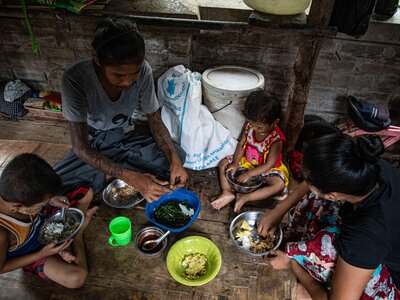Myanmar
- 16.7 million
- people were already food insecure prior to earthquake
- 3.5 million
- people displaced by conflict
- 54.1 million
- population
A 7.7-magnitude earthquake struck central Myanmar on 28 March 2025, killing more than 3,700 people, destroying infrastructure and reverberating through neighbouring countries.
The disaster compounds a humanitarian crisis linked to a multitude of political and socioeconomic challenges.
Myanmar now ranks fifth globally in the number of acutely food-insecure people, making it a hunger hotspot of very high concern.
Conflict and political crises have reversed progress on ending hunger and malnutrition, with a majority of people struggling with physical, social and economic access to food. Women, girls, elderly people, persons with disabilities and minorities are particularly affected.
High levels of food insecurity are particularly prevalent in conflict-affected areas. At the same time, there are massive disruptions or slowdowns in sectors including banking, healthcare, education and transport.
A total of 3.5 million people have been displaced from their homes across Myanmar, including over 3 million since the military takeover in early 2021. Meanwhile, almost 1 million Rohingya refugees from Myanmar remain in Bangladesh.
One in three children under the age of 5 suffers from stunting (low height for their age), while more than half a million children are projected to suffer from wasting in 2025 – a 26 percent rise from 2024. Tuberculosis and HIV infections are also on the rise, amid weakened health services and growing drug use since 2021.
One in three children under the age of 5 suffers from stunting (reduced height for their age), while wasting (underweight for their height) stands at 7 percent nationally. Tuberculosis and HIV infections are also high. Education remains inadequate at all levels, with the poorest households most at risk.
Myanmar remains one of the countries most vulnerable to climate-related disasters. The country was affected by several floods in 2024, including those caused by Super Typhoon Yagi which had a devastating impact on an estimated 1 million people across 11 of the country's 14 states/regions.
The earthquake caused US$11 billion in damages, equivalent to 14 percent of Myanmar’s GDP. As a result, the World Bank projects a 2.5 percent economic contraction in 2025/26, with inflation estimated at 34 percent. The average price of a basic food basket has increased four times compared to before the military takeover, leaving nutritious food out of reach for many.
The World Food Programme (WFP) provides life-saving food and cash assistance to internally displaced people and other vulnerable populations. This support is threatened by severe funding shortfalls, however. WFP also responds to sudden-onset emergencies.
What the World Food Programme is doing in Myanmar
-
Crisis response
-
WFP provides life-saving food and/or cash assistance to people affected by conflict, climate-related disasters and other crises, as well as those who have limited or no livelihood options. In response to the devastating earthquake in March 2025, WFP has reached 400,000 affected people in Sagaing, Mandalay, southern Shan State and Nay Pyi Taw, with emergency food and cash for food.
-
School meals
-
WFP’s school meals programme provides pre- and primary school students with on-site cooked meals or midday fortified biscuit snacks. Cooked meals, while mainly funded by WFP, also include ingredients contributed by parents and the community. Meals are served at schools, religious institutions and learning centres, with strong community involvement. This assistance is complemented by social and behavioural change communication to promote better hygiene and healthy eating habits among children and adolescents.
-
Resilience building
-
WFP implements community-based projects that create and or restore community assets and infrastructure such as feeder roads and land terracing. WFP provides a basic food basket or cash-based assistance, combined with nutrition messaging, to vulnerable people as they participate in the projects. These activities help communities achieve self-reliance, bolster resilience to stresses and shocks, and assist recovery from the impact of disasters. Working with community and local partners, WFP promotes inclusive participation and equal wages for women and men.
-
Nutrition
-
To improve nutrition and reduce wasting and stunting, WFP provides specialized nutritious foods or cash assistance to children, adolescent girls, and pregnant and breastfeeding women, combined with a comprehensive nutrition package. WFP also provides food, cash, specialized nutrition and counselling to people living with HIV and those undergoing tuberculosis treatment, to support nutritional recovery and treatment. WFP hosts the UN Network for Nutrition in Myanmar, strengthening collaboration between UN agencies and partners. WFP has also been engaging with food-related businesses in Myanmar to promote better nutrition through the SUN Business network (SBN Myanmar) since its launch in 2020.
-
Humanitarian support services
-
As the global lead of the Logistics Cluster, WFP provides support and coordination to humanitarian logistics partners. WFP also provides on-demand services such as cash transfers, food transport and distribution, administration, and information technology, as well as warehouse storage. As part of the earthquake response, the WFP-led Logistics Cluster has established free, shared storage facilities for humanitarian partners in Yangon and Mandalay, including temperature-controlled storage.
Myanmar news releases
Go to pageFind out more about the state of food security in Myanmar
Visit the food security analysis pageContacts
Office
United Nations Building No. 20-25 Kyine Tone Street Zawana Theidi Quarter, Oattara Thiri Township Nay Pyi Taw, Myanmar
Nay Pyi Taw
Myanmar (Burma)







